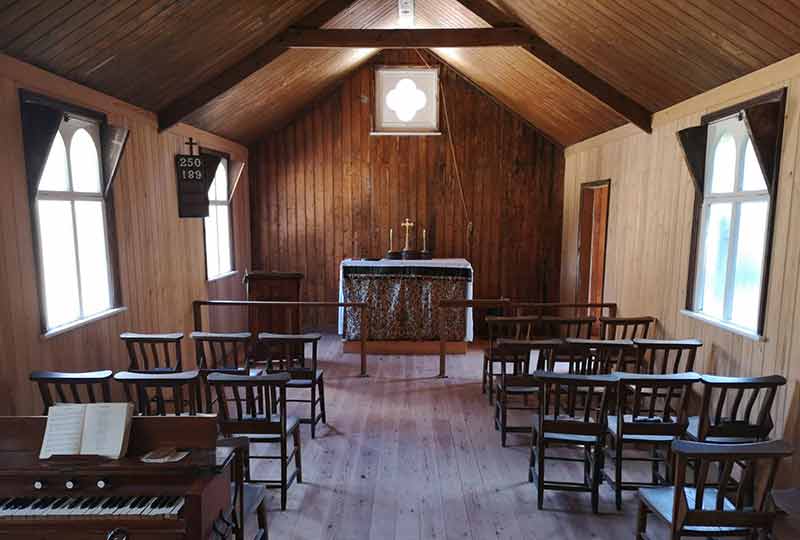
This ‘tin tabernacle’ or ‘iron church’ was built in 1908 to serve as a place of worship for the residents of the new village of South Wonston.
The building is approximately 30 feet long by 15 feet wide, rectangular in shape with a tiny porch and vestry. A short extension to the roof at the east end, supported by shaped brackets, forms a cowl for a bell, with a pulley in the vestry for ringing.
Share
Overview
Dates From
1908
Dismantled
2006
Reconstructed
2011
Original Location
South Wonston, Hampshire
Building History
The Church
The village of South Wonston – part of the parish of Wonston – was created in 1892 when an area of poor quality farmland on a chalk Downland ridge was sold for development. The growth of the village was initially slow – the 1901 census lists only 10 households.
Despite this, the Rector of Wonston thought that it was important to establish a spiritual base for the community and in 1908 he paid £8 of his own money for a plot of land measuring 80 feet by 50 feet for the purpose of erecting a mission room. Within a matter of months, his curate had placed an order with Humphreys Ltd of Knightsbridge, a company specialising in supplying pre-fabricated corrugated iron buildings.
The ‘mission room’ was to be timber-framed, clad with galvanised corrugated iron and measuring 25 feet x 15 feet (although its length as finally built was 30 feet). The interior was to be clad with pine panelling; there would be a porch at the western end, a bell hung externally at the eastern end and a small vestry area added on the southern side.
Money for the structure and fittings was raised largely by public donations, but included the proceeds of a jumble sale, a concert and two offertories. The building was purchased for £89 10s, and the foundations were laid at a cost of £13.
The church, named St Margaret’s Mission Church, was first used on Sunday 7 February 1909, and was formally licensed for divine service as a daughter church by the Bishop of Winchester on 20 December 1909. Baptisms could be performed there and recorded in the Wonston baptism register, but marriages and funerals would take place at the parish church of Wonston.
In the 1920s, the role of St Margaret’s as the focus of community life was enhanced by the addition of a corrugated iron hall, put up next to the church.
As the 20th century progressed, South Wonston expanded rapidly. By the mid-1980s the mission church had become much too small for the size of the congregations, and some services were regularly held in the hall. In 1996 all services transferred to a new church of St Margaret’s built in the centre of the village adjoining the primary school. South Wonston became an ecclesiastical parish in its own right in 2007.

Tin church interior.
In 2006 the iron church was offered to the Museum by the Trustees of the St Margaret’s Mission Trust. It was dismantled the same year and opened as an exhibit building in 2011. The altar, altar cloth, candle stand and hymn board are original to the church; other furnishings have been bought, donated or made at the Museum.
Tin Tabernacles
‘Tin tabernacle’ is the name given to a church or chapel built out of corrugated iron. Usually sitting on a rudimentary brick or rubble and mortar foundation, tin tabernacles were based on a simple bolt-together wooden frame.

They were intended to be temporary and portable, usually providing short-term accommodation for their congregations until they raised the money to build permanent churches.
Many tin tabernacles – or ‘iron churches’ as they were often described – were built to house non-conformist groups like Wesleyans, Baptists and Moravians whose numbers expanded considerably during the religious ‘revivals’ of the 19th century.
However, they were also used to accommodate Anglican congregations during an era of rapid population growth. Pre-fabricated iron churches were also exported to the British colonies, including Australia, South Africa and Canada.
Corrugated iron was invented by Henry Robinson Palmer in 1829 and was being mass produced in England from about 1830. By the second half of the 19th century there were several firms – such as Humphreys Ltd of Knightsbridge and Isaac Dixon & Co of Liverpool – manufacturing a range of iron buildings, including churches, village halls, sports pavilions and warehouses, with production peaking during the 1880s and continuing up until the start of the First World War.
Top 3 Interesting Facts

A Pop-Up Church
As a prefabricated structure bought off the shelf, a new church could be quickly assembled for parish use.

A New Village
The church was built in 1908 to serve a new village, with the local rector keen to provide a spiritual base.

A Permanent Church
The community outgrew the church, a new permanent structure was built and in 2006 this building was offered to us.







